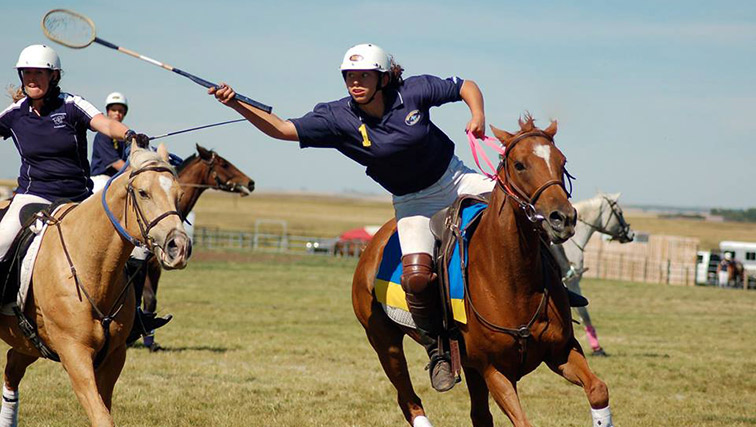A Perfect Match: Polocrosse and OTTBs

Isabelle Ladiges playing polocrosse on off-the-track Thoroughbred “Eleanor”. (Photo courtesy of Ranahan Polocrosse Club)
Created in the 1930s, the modern version of polocrosse has taken the world by storm.
Started in Australia, the game, which is a cross between polo and lacrosse, made its way around the world. America soon joined into the discipline and formed their own association, the American Polocrosse Association, in 1984. It wasn’t long after jumping into the sport that American players realized off-the-track Thoroughbreds (OTTBs) are perfect for the sport.
“We have a mix of all breeds but OTTBs are certainly the best,” said Cathy Ladiges, the owner of Ranahan Polocrosse in Canada. “I think 90 percent of the high level ones in Canada are OTTBs because they are great athletes. They’re fast, they’re smart, they’re bold; we love them.”
Thoroughbreds who come into the sport love it and quickly learn to follow the ball and put their riders in the right position. The athleticism bred into racehorses also helps when it comes to the skills needed to properly play polocrosse in addition to other sports she does with her horses.
“That’s the thing. I find that they are smart, they’re bold, they’re athletic and they love the sport,” she said. “You need a horse that’s fast and handy and bold, but they also have to be in control because you do a lot of changing directions, changing speed and that sort of thing so you can’t have a runaway out there. You have to have a lot of control. “
As the sport only allows the players to use one horse throughout the match, unlike polo, soundness is an important quality. Ladiges has found that Thoroughbreds who raced fill that requirement perfectly for her.
“I find that if you get one off the track and they are sound, then the odds are pretty good that they are going to be sound,” she said. “If there’s something majorly wrong with them, then they aren’t going to make it on the track, especially babies.
Ladiges has traveled the world watching polocrosse and has seen players mounted on Thoroughbreds around the globe. Even in Australia, where polocrosse is most popular, Ladiges sees the country’s riders on Thoroughbreds or part-Thoroughbreds instead of the native Australian stock horses due to the endurance the Thoroughbred breed has.
Horses straight off the track also seem to adapt to their new career quickly, even though it requires skills they’ve never used on the track. Susan Hatch, the mountain zone representative of the American Polocrosse Association, said that the process of getting a Thoroughbred straight from the track ready for polocrosse can take about a year.
“A lot of slow work and a lot of flexing is needed,” she said. “One of the most important things is to get that horse really working on their hind end, which can be a long process for OTTBs but we’ve had a lot of success at it and when they do get working on their hind end, getting a good jump off from a stop, they really do well at it.”
A LOOK INSIDE POLOCROSSE
Video courtesy of Polocrosse South Africa
While Hatch doesn’t understand where Thoroughbreds’ bad reputation came from, she says that a few years of playing polocrosse can calm down even the higher-strung horses. She’s even seen older Thoroughbreds go on to teach younger players how to play the game.
“Polocrosse is very, very good for OTTBs. They have an unfortunate reputation of being a little spastic. After a few years of polocrosse, they are pretty mellow,” she said. “A lot of times in older horses, once they’ve played top level polocrosse, maybe they aren’t quite up to it anymore they will go to kids and the kids will start playing them. We had an OTTB gelding who played until he was about 20 and I can’t tell you the amount of kids he taught to play.”
As for the relationship between racing and polocrosse, Cathy Ladiges says the sports have a good relationship.
Polocrosse players understand just how important racing is as it provides them with horses for the sport and those in racing like polocrosse players because of the horses they look for.
“The perfect size for our horses is about 15.3 and we love mares. Those are sometimes the harder ones to rehome and that’s what we like. So they love it when we come calling,” she said.
Polocrosse is still growing in North America but in 2015 Thoroughbreds in the sport will gain more recognition.
Ladiges’ Ranahan Polocrosse club will be giving out awards from The Jockey Club’s Thoroughbred Incentive Program (T.I.P) for the Best Playing Thoroughbred Pony, the first time polocrosse has been included in the program’s awards. Kristin Werner Leshney, The Jockey Club’s legal associate and a T.I.P organizer hopes this award encourages other polocrosse clubs to apply.
"I'm thrilled to have T.I.P work with Ranahan Polocrosse to give out a polocrosse award,” said Werner Leshney. “We hope that this encourages other polocrosse clubs to apply for the ability to give T.I.P awards to their outstanding Thoroughbred contestants in 2016 and beyond. My future goal for T.I.P is to give The Jockey Club the ability to recognize the best Thoroughbred in each discipline in the country and bringing the program to polocrosse clubs is the first step towards including polocrosse in that goal.”
Those who want to learn more about polocrosse in the United States can visit www.americanpolocrosse.org.
